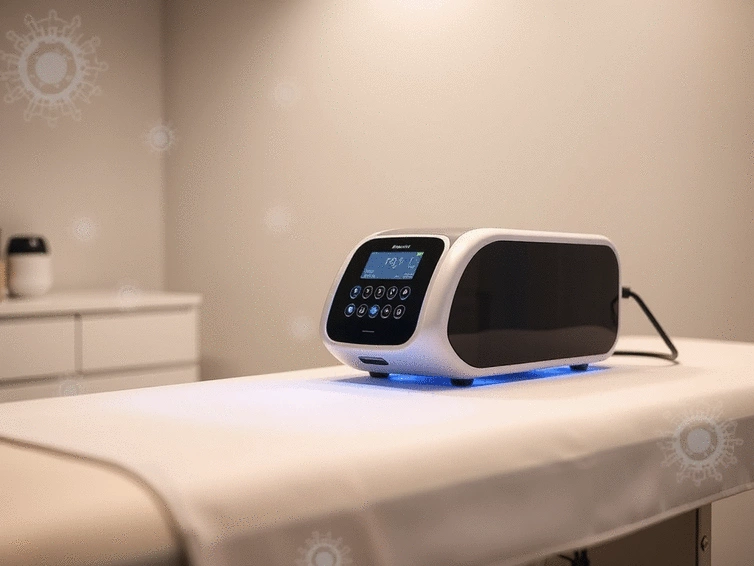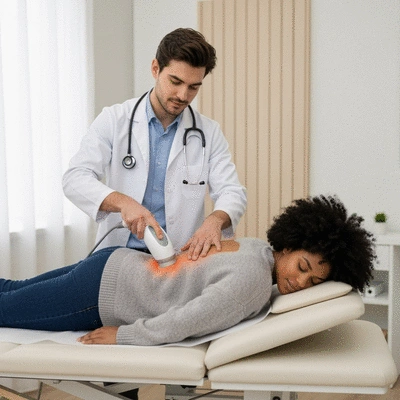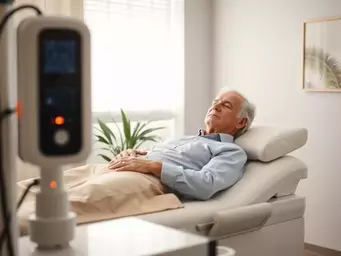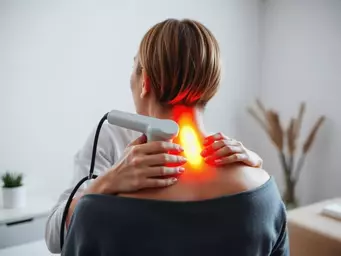Photobiomodulation: The Core Mechanism
Specific wavelengths (e.g., 635 nm) stimulate cellular activity, enhancing natural healing processes.

Curious about how light can promote healing? The science behind low-level laser therapy (LLLT) reveals a fascinating interplay between light and cellular processes that could change the way we approach pain management and recovery.
This visual summarizes the core scientific mechanisms of how Erchonia Low-Level Laser Therapy (LLLT) works at a cellular level, along with its clinical validation and comparative advantages.
Specific wavelengths (e.g., 635 nm) stimulate cellular activity, enhancing natural healing processes.
Welcome! Today, we’re diving deep into the fascinating world of low-level laser therapy (LLLT) and its science. At Erchonia Laser, we understand that exploring how this innovative therapy works is essential for both practitioners and patients. By utilizing specific wavelengths of light, such as 635 nm, LLLT interacts with cellular components to promote healing and recovery. Let's unpack the core mechanisms behind this transformative therapy!
At the heart of LLLT is the concept of photobiomodulation, which refers to how light photons stimulate cellular processes. When we apply laser light to tissues, it enhances cellular activity, leading to increased healing rates. This is particularly vital for conditions involving pain and inflammation. For a deeper understanding of this process, you can refer to this comprehensive review on photobiomodulation.
By shining light on cells, we encourage them to function at their best, almost like giving them a gentle nudge to heal naturally. This dynamic interaction is crucial in understanding how LLLT can change lives.

One of the key players in this process is cytochrome c-oxidase, a chromophore found in our cells. This molecule plays a significant role in energy production by facilitating the process of respiration. When LLLT is applied, it enhances the absorption of light by these chromophores, leading to more efficient energy production, as detailed in scientific literature on cellular energy production.
As a result, cells can repair themselves more effectively, leading to improved healing outcomes. Understanding the role of chromophores helps us appreciate the underlying science of LLLT and its potential benefits.
Another critical aspect of LLLT is its ability to increase ATP (adenosine triphosphate) levels in cells. ATP is often referred to as the "energy currency" of the cell. Higher ATP levels mean that cells can perform their functions more efficiently, leading to quicker repair and regeneration processes.
When we utilize Erchonia's LLLT devices, we see significant improvements in patient outcomes, underscoring the importance of ATP in healing.
Another fascinating element of LLLT is how it influences nitric oxide levels in the body. Nitric oxide plays a vital role in promoting vascularization, which is essential for tissue regeneration. By increasing blood flow, it helps deliver the necessary nutrients and oxygen to healing tissues.
This process leads to enhanced recovery from injuries and conditions like chronic pain. The interplay of nitric oxide and LLLT showcases the powerful healing potential of this therapy.
Now that we've explored the science, let’s highlight the clinical evidence supporting Erchonia’s devices. Our commitment to safety and efficacy is reflected in numerous FDA approvals and rigorous clinical trials. These trials validate the transformative effects of LLLT on various conditions, reinforcing our dedication to advancing non-invasive healing methods.
By focusing on evidence-based practices, we at Erchonia Laser empower both practitioners and patients to make informed decisions about their health and wellness journeys.

In summary, clinical studies related to Erchonia LLLT devices have shown promising results in managing pain and enhancing recovery. For instance, one study, such as this registered clinical trial, reported a significant reduction in chronic pain levels among patients after several sessions. These findings affirm our belief in the efficacy of LLLT as a valuable therapeutic option.
To further illustrate our commitment to excellence, we created a comparative table showcasing Erchonia’s technology against other LLLT brands:
| Device Brand | Mechanism | Clinical Results |
|---|---|---|
| Erchonia | 635 nm wavelength targeting | Significant pain relief and improved recovery |
| Brand A | Multiple wavelengths | Moderate pain relief reported |
| Brand B | Broad-spectrum light | Limited clinical evidence |
This table highlights the advanced technology and positive outcomes associated with Erchonia devices, reinforcing our position as a leader in LLLT.
Lastly, it's essential to explore the body of evidence through systematic reviews and meta-analyses assessing both the safety and efficacy of Erchonia LLLT. These studies often conclude that not only is LLLT effective, but it also boasts a strong safety profile.
In our next section, we’ll address safety concerns and common myths surrounding low-level laser therapy. It’s vital to have accurate information as you explore your treatment options!
Studies have shown that low-level laser therapy can result in a 70% improvement in chronic pain patients after just a few sessions. This highlights its effectiveness as a non-invasive treatment option for pain management and recovery.
LLLT, also known as photobiomodulation, is a non-invasive therapy that uses specific light wavelengths (e.g., 635 nm) to stimulate cellular activity, promoting healing, reducing pain, and decreasing inflammation.
LLLT works by stimulating chromophores, like cytochrome c-oxidase, within cells. This absorption of light leads to increased ATP production, enhanced cellular repair, and the release of nitric oxide, which improves blood flow and nutrient delivery.
The 635 nm wavelength is specifically targeted to optimize cellular response, leading to significant pain relief and improved recovery. This focused approach distinguishes Erchonia devices from broad-spectrum or multi-wavelength devices.
Yes, Erchonia LLLT devices have numerous FDA clearances and extensive clinical trials that confirm their safety and efficacy across various conditions, demonstrating positive outcomes in pain management and recovery.
The main benefits include enhanced cellular healing, increased ATP production for faster repair, improved blood flow through nitric oxide release, significant pain relief, and reduced inflammation, all supported by clinical evidence.
As we wrap up our exploration of Erchonia Low-Level Laser Therapy (LLLT), it's essential to reflect on the fundamental mechanisms we discussed and the compelling clinical evidence supporting its use. We’ve seen how photobiomodulation works at the cellular level, promoting healing through enhanced ATP production and the role of nitric oxide in tissue regeneration. Moreover, the numerous FDA approvals highlight the safety and effectiveness of Erchonia devices in various applications.
Understanding these mechanisms provides a solid foundation for appreciating the therapeutic potential of LLLT. The studies supporting Erchonia's efficacy not only demonstrate positive outcomes for patients but also reinforce the credibility of this innovative treatment modality. This knowledge empowers both practitioners and patients to make informed decisions about incorporating LLLT into their wellness strategies.
We believe that discussion is key to advancing understanding in any field. I invite you to engage with this content—share your thoughts, experiences, or questions about LLLT! Whether you're a healthcare professional or a patient seeking pain relief, your insights can contribute to a broader conversation about this transformative therapy.
By fostering open dialogue, we can all learn and grow together. At Erchonia, we are committed to keeping our community informed about the latest research and developments in LLLT. Your voice matters, and sharing your story can inspire others on their healing journeys!
To stay updated on ongoing research and insights in the field of low-level laser therapy, I encourage you to follow our blog regularly. Additionally, sharing your personal experiences with Erchonia LLLT can provide comfort and motivation to those seeking relief from chronic pain or other ailments. Together, we can illuminate the path to wellness and empower more individuals to explore the benefits of LLLT!
Here is a quick recap of the important points discussed in the article:
Understanding Red Light Therapy

Curious about how light can play a pivotal role in healing? The world of light therapy is rich with
Erchonia Laser Therapy for Pain Management

Curious about a non-invasive solution to chronic pain? Erchonia Laser Therapy is emerging as a revol
Relieving Neck and Shoulder Pain

Consider this: neck and shoulder pain affects millions, yet many are unaware of the root causes. Und
Understanding Red Light Therapy
Erchonia Laser Therapy for Pain Management
Relieving Neck and Shoulder Pain
Erchonia Laser and Back Pain Outcomes
Exploring Erchonia's Laser Technology Science